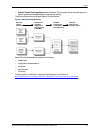
Chapter 1: Introduction
2 Netcool/Proviso Cisco IP Telephony Technology Pack User’s Guide, Version 4.3-W
Technology Pack. The grouping rules use the properties and values defined within inventory formulas or
adaptor design files to filter the sub-elements into their appropriate collection or reporting groups.
• For non-SNMP network resources, a Technology Pack provides a Bulk Adaptor Design File. Bulk Adaptor
Design Files define how data fields that reside in files generated by network resources are used to create sub-
elements and set values for items defined as properties.
During the database synchronization phase of the inventory process, the list of discovered sub-elements is
compared to what exists in the database. Newly discovered sub-elements are assigned a resource identifier (RID)
and timestamp, and the database uses both items to create a new entry for the sub-element to reflect the known
state of the network inventory.
Collection
Following the completion of the inventory process, Netcool/Proviso is ready to collect performance data for a
Technology Pack’s target network resources. A Technology Pack provides Netcool/Proviso with collection
formulas that instruct a DataLoad collector residing in a DataChannel to collect specific types of performance
data against a particular sub-element.
The types of collection formulas applied to the data depend on whether the sub-element is an SNMP resource
or non-SNMP resource:
• For SNMP network resources, a Technology Pack provides SNMP collection formulas. SNMP collection
formulas instruct the SNMP Collector to take the data gathered during a specified collection interval,
perform some mathematical operation on the data, and output the result as a performance metric.
• For non-SNMP network resources, a Technology Pack provides Bulk collection formulas. A Bulk collection
formula, unlike an SNMP collection formula, has no executable instructions. A Bulk collection formula
consists of a metric name that is mapped by the Bulk Adaptor Design File to a statistic that resides in the
input file generated by a network resource.
Either type of collection formula outputs a metric and corresponding unique metric identifier (MID) that are
passed along the DataChannel to the Complex Metric Engine for processing.
How is the Data Processed and Loaded into the Database?
The Complex Metric Engine (CME) is a component in the DataChannel that performs calculations on data
gathered by the SNMP or Bulk collectors deployed in a network. These calculations include the following:
• Pre-defined formulas that are provided by a Technology Pack
• User-defined formulas created using the CME Formula API
• Time aggregations for sub-elements
In addition to performing calculations on the data stream in the DataChannel, the CME also buffers and sorts
metric records according to their RIDs and MIDs to optimize how the data and metrics are stored in the database.


















